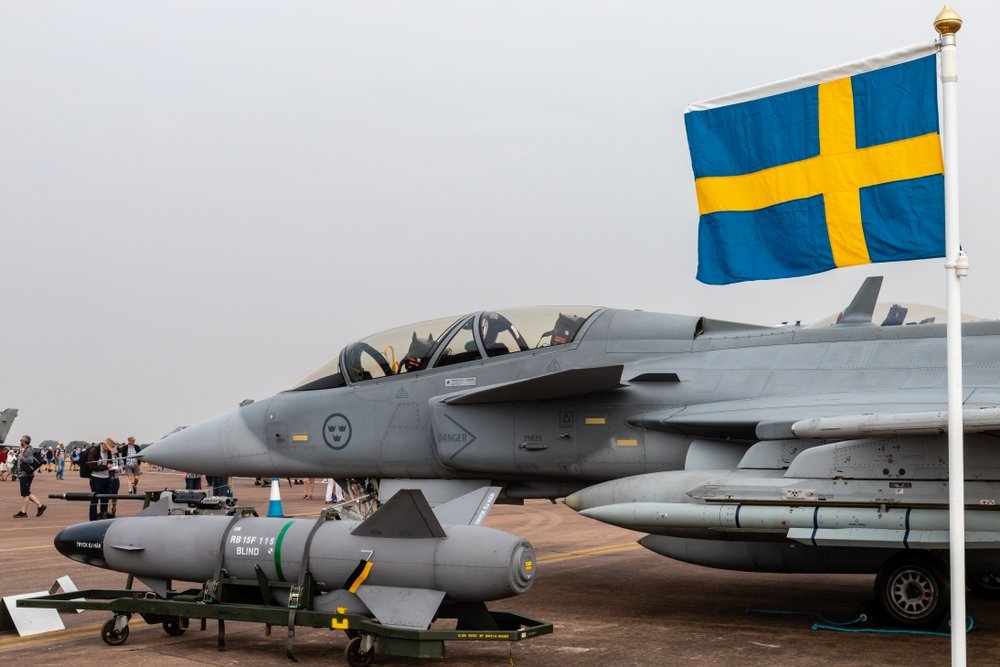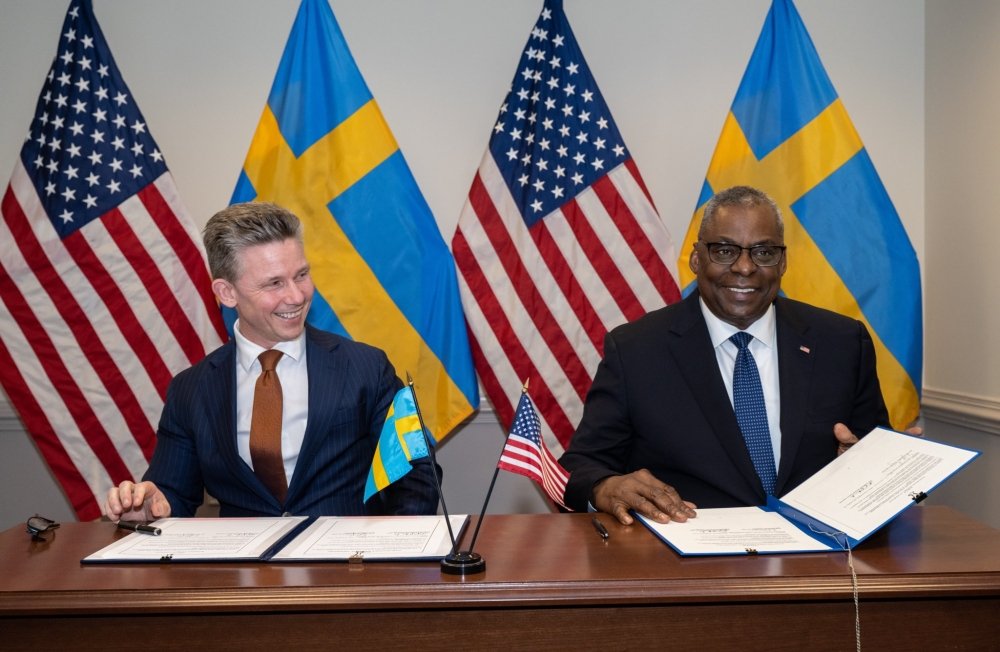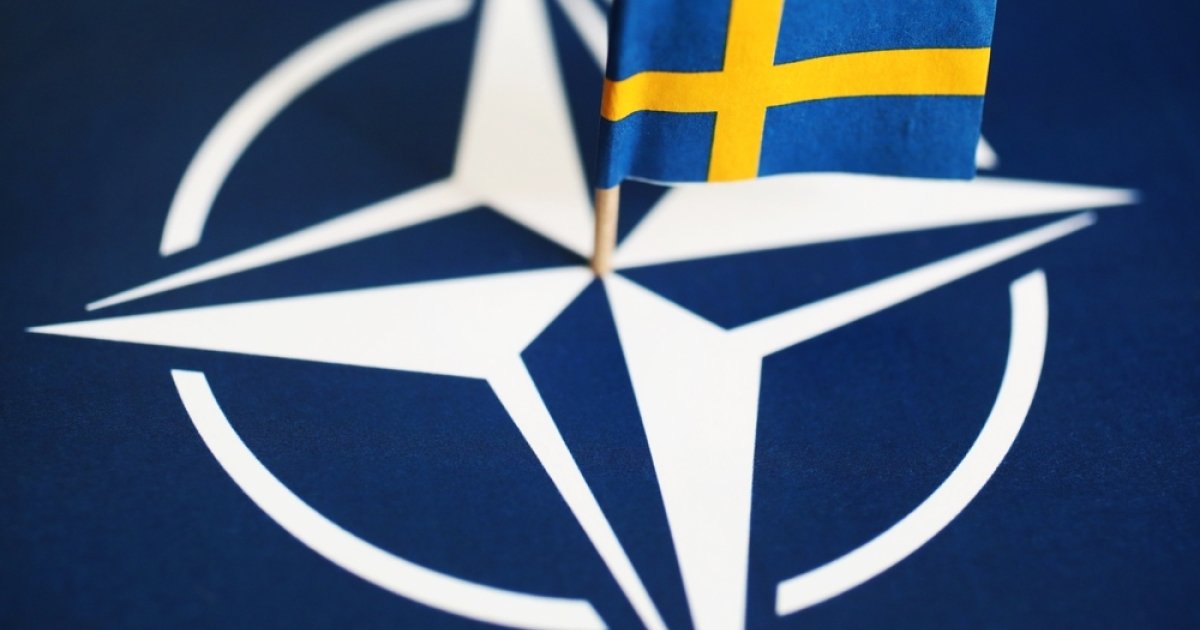When Sweden applied for NATO membership on May 22, 2022, it ended two centuries of military non-alignment. Although it was swiftly ratified by most NATO members, Türkiye and Hungary have prolonged the accession process. With ratification from Türkiye in hand, all eyes are on Hungary next, with Sweden set to become the 32nd member of the NATO Alliance in the coming weeks. Sweden has a highly advanced military and is a net contributor to the defensive alliance; its membership represents a considerable boost to NATO capabilities. As a member of NATO, Sweden will provide the Alliance with 1) support from its strong defense industry, 2) high-technological competence, and 3) a significant air force. These contributions will be crucial in preparing the Alliance to combat modern threats, as well as providing a dramatic multiplier to NATO’s capacity in two vital regions—the Baltic Sea region and the Arctic. With Sweden’s modern and diverse capabilities soon to be added to NATO’s toolkit, it is worth taking a look at what the country will contribute to the Alliance, now and in the future.
Three Major Benefits of Sweden Joining NATO
There are three main areas where Sweden will be able to contribute tangible benefits. First is Sweden’s defense industry, which will boost the Alliance’s military-industrial capacity. One of the largest in Europe, Sweden’s defense industry amounted to $3 billion in 2022 with exports of defense material totaling over $2 billion. The country’s largest defense companies produce some of the most sophisticated equipment on the market, such as Saab’s Jas 39 Gripen and BAE System AB’s Combat Vehicle 90. Approximately 28,000 people are employed by Sweden’s defense industry, a figure likely to rise as the government has announced a considerable increase in its annual defense budget for 2024; nearly double that of its 2020 defense budget. The high demand for defense production, which has struggled to keep up with weapons demands as countries provide armaments to Ukraine in the wake of Russian aggression, is only going to continue for the coming years.
The second benefit is the high level of technological competence in Sweden’s private sector. Sweden’s extensive public-private partnerships, considerable R&D funding, and highly-ranked education system are some of the factors behind its success in high-tech. The government launched a national ‘Cybercampus’ initiative in 2020 in partnership between the Swedish Defense Forces, public universities, and private companies, and established the Centre for Cyber Defence and Information Security in Stockholm. As NATO expands its ability to counter cyber and hybrid threats, Sweden’s technological know-how will help prepare the Alliance to prepare for tomorrow’s threats.
In addition, with Sweden in NATO, two of the three manufacturers of 5G equipment—Ericsson and Nokia—will be in the same defensive alliance. The country is home to leading high-tech firms, such as Ericsson, the world’s second largest network company; Hexagon, a major software company; and Northvolt, one of Europe’s largest producers of lithium batteries. Sweden’s success in attracting tech startups and in producing unicorns (startups reaching a billion dollar valuation) has led the country to be informally dubbed the ‘Silicon Valley of Europe’. Sweden also possesses large quantities of critical minerals—such as iron ore and rare earth metals—which are vital for the defense industry, in the green transition, and for the overall economy. After a recent discovery in the Northern Swedish city of Kiruna, the country now possesses the largest-known deposit of rare-earth metals in Europe. Sweden will provide the Alliance with a crucial opportunity to reduce its critical minerals dependency on China and other authoritarian governments.
The third benefit is Sweden’s air force. The country’s air force is the largest in the Nordics and one of the largest in Europe, possessing at least 100 fighter jets. With many more slated to be delivered in the upcoming years, Sweden is set to dramatically bolster the Alliance’s number of fighter jets in the Baltic and Arctic regions. This will reduce the need for other major allies such as the United States to provide air surveillance and air presence in the region, with NATO member states now able to take a larger role in their own region’s defense. Although Sweden’s air capabilities are significant, it is one of only a few European countries, and the only Nordic country, that flies the Gripen. Sweden, along with the other Nordic countries—Norway, Finland and Denmark—signed the Nordic Air Commander’s Intent in March 2023, with the goal of combining air capabilities to better deter Russia. As the individual Nordic air forces seek to unite under a common purpose, Sweden remains the odd one out with its Gripen fighters, the others all use the Lockheed Martin-designed F-16 or F-35. Sweden’s commitment to the Gripen has previously put it at odds with the United States, a decision which will likely be discussed more in the upcoming years as Allied cooperation intensifies.

A Swedish Air Force Saab Gripen fighter.
Shutterstock/Richard Whitcombe
https://www.shutterstock.com/image-photo/fairford-england-july-13-swedish-air-1141984547
Bolstering NATO’s Northern Corridor
Sweden’s membership is also beneficial for NATO given Sweden’s geostrategic location in the heart of the Nordics. This is the first time all of the Nordic countries have been in the same alliance since 1523—after Finland’s accession to NATO in April 2023. With Sweden as a member, the Alliance will gain strategic depth in the Baltic Sea region. Most countries around the Baltic Sea will now be part of the same military alliance, which has led some people to dub the Baltic Sea a ‘NATO lake’. Sweden’s entry into the Alliance will add three new strategic locations to the Alliance: 1) the strait of Øresund, the main strait connecting the North Sea to the Baltic Sea, which will now be completely controlled by NATO members; 2) Gotland, the largest island in the Baltic Sea, often called an ‘unsinkable aircraft carrier’ due to its central location in the Baltics; and 3) shoreline along the Åland Sea and Gulf of Bothnia will make it easier for the Alliance to defend Åland, a demilitarized region between Finland and Sweden at the entry of the Gulf of Bothnia. Sweden is increasing its military presence in these areas, most notably on Gotland. In recent years, Sweden has relocated a mechanized battalion and anti-aircraft capabilities, as well as put aside specific financing of $163 million for the defense of Gotland. NATO access to Gotland will dramatically increase its force projection capabilities into the Baltic Sea region.
Sweden also possesses a world-class submarine fleet—with some of the most advanced submarines in operation—and a wealth of knowledge navigating the shallow Baltic Sea, which it has done since 1904. Sweden’s fleet currently consists of three advanced Gotland-class submarines and one older model scheduled to be retired when two new designs are delivered in 2027 and 2028, giving it five submarines by the end of the decade. Critically, the entirety of US submarine capabilities and a major portion of Russia’s submarine fleet are unable to operate in the shallow Baltic Sea. Sweden fills a crucial gap in capabilities for NATO in the Baltic Sea region with its long history of submarine expertise and modern capabilities.
Sweden’s membership will also be a game changer for NATO in the Arctic region. When Sweden joins NATO, seven of the eight Arctic states—all except for Russia—will be part of the same Alliance. With climate change poised to open new sea lanes and possibilities for resource extraction such as hydrocarbons and critical minerals, the region is becoming gradually more important both commercially and militarily. This rising geopolitical interest for the region by Arctic states—especially Russia—will require greater cooperation among NATO members to strengthen deterrence in the region. China too is increasingly interested in the region, and with intensifying Sino-Russian relations, it is potentially a new theater in the ongoing great power competition. Sweden too has noted the importance of the Arctic region and is in a process of enhancing its presence in the Arctic. This is evident from the Swedish government’s recent decision to start construction on two new garrisons in northern Sweden. Russia is investing heavily in its Arctic capabilities, so too must NATO invest in its capabilities in the region. Adding Sweden as a member significantly increases NATO’s access to Arctic infrastructure, training opportunities, and adds Sweden’s expertise operating in the region to the Alliance’s capabilities.
Increased Cooperation and Bolstered Capabilities
In addition to the immediate benefits Sweden will bring to the Alliance, there are also future benefits to realize. Since Russia’s annexation of Crimea in 2014, Sweden has pursued a strategy of increased spending on the military and rearmament. This strategy has been accelerated since Russia’s full-scale invasion of Ukraine in 2022. The country’s recent decision to increase military spending by 28% for FY2024 will bring military spending above the 2% target six years earlier than planned—showcasing Sweden’s commitment to be a trustworthy partner in the Alliance. The increased funding will go towards bolstering some of Sweden’s current weaknesses, such as its low number of personnel and reservists. The annual number of recruits will increase from 5,500 to 10,000 and will give Sweden one of the largest reserve forces in the Alliance. It is also planning to reactivate civilian conscription in an effort to bolster its personnel and boost its defensive capabilities.
Sweden’s NATO membership also opens up new possibilities of defense cooperation, both on the Alliance level and regionally. Sweden’s long position of military non-alignment has led it to historically underutilize cooperation with other like-minded partners on defense and security. The upcoming years will therefore provide Sweden and the Alliance many opportunities to deepen cooperation with integration and synergies. There are also numerous opportunities for increased regional cooperation outside of NATO, most notably with bodies such as 1) the Nordic Defense Cooperation (Nordefco), a defense collaboration bringing together the five Nordic countries; 2) the Nordic Council, an inter-parliamentary body for Nordic cooperation (and which has historically not discussed defense due to Sweden and Finland’s military non-alignment); 3) and bilateral defense cooperation between Sweden and Finland. A sign of increased cooperation was evident earlier this year, when the air force commanders of Sweden, Finland, Denmark and Norway issued a joint declaration, with a shared goal to operate all Nordic fighter jets as one fleet. This announcement–made during the early days of the Swedish presidency of Nordefco–would result in a joint fleet of at least 250 fighter jets, and possibly as many as 400, although it is difficult to say how many are in active use.

A bilateral Defense Cooperation Agreement was signed by the Swedish Minister for Defence Pål Jonson and the United States Secretary of Defense Lloyd J. Austin III on the 5th of December 2023. After the Riksdag approves and implements it, the Agreement should enter into force by late 2024.
X (formerly Twitter)/United States Secretary of Defense Lloyd J. Austin III
https://twitter.com/SecDef/status/1732211325114470757/photo/1
Sweden is also in the process of increasing its ties to other partners, including the United States, with whom Sweden concluded negotiating a Defense Cooperation Agreement (DCA) in December 2023. This bilateral agreement provides a framework for defense cooperation, outlines the terms for US troops in Sweden, should the need or desire ever arise, and deepens defense relations within NATO. Another important partner is the United Kingdom, with whom Sweden has cooperated more in recent years through the Joint Expeditionary Force (JEF)—a UK-led defense initiative consisting of ten Northern European countries. Sweden in NATO marks all of the JEF countries in both frameworks, enhancing opportunities for multi-domain interoperability in the high north. Additionally, Sweden has committed to sending at least 600 troops to Latvia in 2025 as part of a NATO-led multinational battle group. These forward placed units act as a deterrent to Russia and are a visible sign of Sweden’s commitment to be a net contributor to NATO.
Sweden’s decision to apply for NATO membership and its dramatic reinvestment in its military since the Russian annexation of Crimea represents a profound shift in the Nordic nation’s military policy. With a robust defense industry, numerous high-tech companies—including one of the major producers of 5G infrastructure equipment—vital geostrategic location, and a powerful air force that increases force projection into the Baltic Sea and shores up the Northern corridor, Sweden stands to contribute significantly to the alliance from day one as a member. Together with Finland and its Nordic neighbors, Sweden is undertaking a profound integration of air capabilities and a new Nordic dimension to the alliance is emerging. As NATO’s newest member, Sweden will join with a profound array of capabilities and dramatically transform the Northern corridor of the Alliance.
